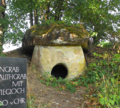Horgen culture
| Geographical range | SouthernGermanyandSwitzerlandnearLake Constance,Rhineriver basin. |
|---|---|
| Period | LaterNeolithic,Chalcolithic |
| Dates | 3,500–2,850 BC |
| Characteristics | simple pottery, well-developed stone tools, lake shore settlements |
| Preceded by | Pfyn culture,Cortaillod culture |
| Followed by | Corded Ware culture,Bell Beaker culture |
TheHorgen cultureis one of severalarchaeological culturesbelonging to theNeolithicperiod ofSwitzerland.The Horgen culture may derive from thePfyn cultureand early Horgen pottery is similar to the earlierCortaillod culturepottery ofTwann,Switzerland.[1]It is named for one of the principal sites, inHorgen,Switzerland.
Dates
[edit]
The Horgen culture started around 3500/3400calBC and lasted until 2850 cal BC. Tree ring dates range from 3370 – 2864 BC.[1]
Distribution
[edit]The Horgen core area is in Northern Switzerland and Southwest Germany nearLake Constance,but it may have reached farther north along theRhineRiver.[1]It may have had ties to the FrenchSeine-Oise-Marne culture. [2]Sites include Horgen,Hauterive-Champréves,Eschenz,andZürich.
AtFeldmeilen-Vorderfeld andMeilenon the right bank ofLake Zurichnear Zürich, four layers ofPfyn cultureartifacts (4350-3950 BCcalibrated) are followed by five Horgen culture (3350-2950 BC) layers were found at Feldmeilen. In nearby Meilen, one Pfyn layer (4250-4000 BC) followed by three Horgen (3300-2500 BC) layers were discovered.[3]
Traits
[edit]There were three phases of pottery; early, middle, and late. The early pottery exhibits an affinity with the Pfyn and maybe the Cortaillod at Twann, Switzerland. The spindle whorls on the pottery may indicate connections to the southernFunnelbeaker cultureand earlyBaden culture.The middle phase (found at Naschdorf-Strandbad, Lake Constance and Dullenried,Federsee) may be influenced by more westerly traditions. The final Horgen phase exhibits similarities to the Burgerroth,Wartberg,and Goldberg III cultures.[1]
The pottery was less refined and decorated than the earlier Cortaillod culture. However, the flint industry was well developed and produced elegant stone tools.[2]
Pigs became increasingly important during the Horgen era. Pig bones were the most common bones found in the villagemiddenheaps, accounting for up to 70% of all bones.[4]
The Horgen culture practiced copper smelting to a limited extent, though copper finds are rare and evidence of processing is sporadic.[5]Ötzi the iceman,who was found with a copper axe, also had stone tools of Horgen culture type.[6]
Gallery
[edit]
-
Wooden wheel fragment, c. 3000 BC[7]
-
Alpine copper axe, 4th millennium BC
See also
[edit]- Schwörstadt-type dolmen
- Prehistoric pile dwellings around the Alps
- Prehistoric pile dwellings around Lake Zurich
References
[edit]- ^abcdComparative Archeology WebArchived2010-11-02 at theWayback Machineaccessed 28 June 2010
- ^abBarbara A. Purdy; National Endowment for the Humanities; University of Florida (1988).Wet site archaeology.CRC Press. pp. 80–.ISBN978-0-936923-08-6.Retrieved28 June2010.
- ^Rainer Berger; Hans Eduard Suess (1979).Radiocarbon dating: proceedings of the ninth international conference, Los Angeles and La Jolla, 1976.University of California Press. pp. 104–107.ISBN978-0-520-03680-2.Retrieved7 July2010.
- ^Francesco Menotti (2004).Living on the lake in prehistoric Europe: 150 years of lake-dwelling research.Routledge. pp. 154–.ISBN978-0-415-31719-1.Retrieved28 June2010.
- ^ielsen, Ebbe (2016)."Neolithic Copper Artefacts from the Canton of Lucerne (Central Switzerland)".Archaologisches Korrespondenzblatt.46(2): 149–165.
During the late Neolithic Horgen Culture (approx. 3300-2800 BC), copper fnds are rare in eastern and central Switzerland, and evidence of processing is only sporadically established.
- ^Wierer, U. (2018)."The Iceman's lithic toolkit: Raw material, technology, typology and use".PLOS ONE.13(6): e0198292.Bibcode:2018PLoSO..1398292W.doi:10.1371/journal.pone.0198292.PMC6010222.PMID29924811.
- ^Bondar, Maria (2023)."The paradigm shift in the later fourth millennium BC: Why did life change in the Middle Copper Age in the heartland of the Carpathian Basin?".Acta Archaeologica Academiae Scientiarum Hungaricae.74(1): 1–21.doi:10.1556/072.2023.00001.













![Wooden wheel fragment, c. 3000 BC[7]](https://upload.wikimedia.org/wikipedia/commons/thumb/4/4a/Landesmuseum_W%C3%BCrttemberg_Stuttgart_Neolithikum_156.jpg/120px-Landesmuseum_W%C3%BCrttemberg_Stuttgart_Neolithikum_156.jpg)
